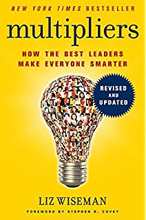How to Make Your Organization Smarter: A Conversation with Renowned Business Leadership Consultant Liz Wiseman

While we read and consult a number of business leadership books to help our clients, one book recently stood out for its compelling research and guidance: Multipliers: How the Best Leaders Make Everyone Smarter, by Liz Wiseman.
Liz is CEO of the Wiseman Group, a leadership research and development center headquartered in Silicon Valley. As a former executive at Oracle Corporation, Liz served as the vice president of Oracle University and as a global leader for human resource development at the company before launching her own firm. With clients that include Apple, AT&T, Disney, Facebook, Google, Microsoft, Nike, Salesforce, Tesla, and Twitter, Liz has been named one of the top 10 leadership thinkers in the world.
Multipliers versus Diminishers
 Liz describes two dramatically different types of leaders: “multipliers” and “diminishers.” As she explains, diminishers drain intelligence, energy and capability from those around them by trying to be the smartest people in the room. They sap energy, kill ideas, and diminish talent and commitment. By contrast, multipliers use their energy and intelligence to amplify the smarts and capabilities of their teams. With a multiplier’s leadership, ideas flow, problems get solved, and teams feel motivated to work.
Liz describes two dramatically different types of leaders: “multipliers” and “diminishers.” As she explains, diminishers drain intelligence, energy and capability from those around them by trying to be the smartest people in the room. They sap energy, kill ideas, and diminish talent and commitment. By contrast, multipliers use their energy and intelligence to amplify the smarts and capabilities of their teams. With a multiplier’s leadership, ideas flow, problems get solved, and teams feel motivated to work.
A third type of leader falls somewhere in between – the “accidental diminisher,” whom Liz describes as a leader with good intentions but who is, nonetheless, having a diminishing effect on the people he or she leads.
We started exploring this book because a client found Liz’s guidance worked well as he looked to transform the work of his team. In fact, this leader at a large health care services company considered himself an “accidental diminisher” who wanted to engage his team but tended to micromanage or take too much ownership of the strategic process. To enhance his own leadership style, the leader used Liz’s guidance to put more trust in his team, motivate them, and help them to be more efficient.
To follow is a fascinating interview we had with Liz, exploring her years of research on leadership, and her advice for helping earnest leaders turn things around for their organizations today. We hope you enjoy it as much as we did, and welcome you to post responses to our questions about these topics in the comments section below.
A Q&A with Liz Wiseman
Q: What motivated you to study this phenomenon of multipliers in the first place?
 A: It was really just an observation that grew into a bit of an obsession. Isn’t that always how it goes? The deepest roots came from landing inside a company with a lot of really smart people, people hired for their intelligence and drive. Oracle had this hiring philosophy back when I joined. They hired at 17 distinct schools, all the top schools in the nation, and they wanted raw intelligence, a hyper achievement drive, and they were also looking for “nice” people. Having worked there for a number of years, I can assure you that they rarely compromised on intelligence or achievement, but they sometimes compromised on nice, because not everyone was. In any case, I think that was really the seed that germinated over almost two decades, where I noticed that sometimes really smart people can suck the intelligence out of a room. I watched some really smart people walk into a room and everyone else would hold back. That was the percolation for the idea, but it wasn’t until I left and started coaching some executives who were also really smart but struggling to engage their team that I began to explore this further. There wasn’t any research done on this, and I wanted to go figure that out.
A: It was really just an observation that grew into a bit of an obsession. Isn’t that always how it goes? The deepest roots came from landing inside a company with a lot of really smart people, people hired for their intelligence and drive. Oracle had this hiring philosophy back when I joined. They hired at 17 distinct schools, all the top schools in the nation, and they wanted raw intelligence, a hyper achievement drive, and they were also looking for “nice” people. Having worked there for a number of years, I can assure you that they rarely compromised on intelligence or achievement, but they sometimes compromised on nice, because not everyone was. In any case, I think that was really the seed that germinated over almost two decades, where I noticed that sometimes really smart people can suck the intelligence out of a room. I watched some really smart people walk into a room and everyone else would hold back. That was the percolation for the idea, but it wasn’t until I left and started coaching some executives who were also really smart but struggling to engage their team that I began to explore this further. There wasn’t any research done on this, and I wanted to go figure that out.
Q: You described many examples of multipliers and diminishers in your book. Who stands out for you? Who do you feel really demonstrates the power of being a multiplier?
A: I was looking for some new heroes. The book is full of people who you wouldn’t recognize their name, but the way that they lead is really inspiring and impactful. One of my personal favorites is Bill Campbell, former CEO of Intuit. In selecting the leaders to profile, it wasn’t about who I liked. I went out and asked other people about their experience with leaders. I really think leadership is in the eyes of the beholder, that a good leader is defined by his or her followers. I was at Kleiner Perkins, a venture capital firm, talking to a couple of partners there and they pointed me to Bill Campbell, who had been at Intuit and was an advisor to many of Silicon Valley’s big entrepreneurs. I went to Bill thinking I was doing a multipliers interview because they said Bill had that effect. Yet when I talked to him, Bill said he began his career as one of the great diminishers of all time. He told me that he began his career telling everyone what to do, then he talked me through how he realized that he was having a diminishing effect and how he made changes. Not only did he become a great multiplier leader himself, but he became a multiplier of multipliers.
When I described the multipliers idea to Bill, he said that’s what he was trying to teach some of the founders of companies that he was working with, people like Jeff Bezos (CEO of Amazon) and Larry Page and Sergey (Brin), the founders of Google, and all of their portfolio companies. He said he was looking at how to help them grow as a leader, from being the lone genius who started a company to harvesting the intelligence of the team and leading in a very different way. You might know that Bill passed a few years back and was beloved in Silicon Valley, where I live. I love his example because it proves that real and lasting change is possible.
The Mike Felix (telecom and software executive) example is also great. In some ways, it’s the opposite of Bill Campbell’s example. It’s about someone who already started out as a really great leader who used this concept of multipliers to just get even better and to turn around the Midwest Internet and Entertainment Services division at AT&T. When he took the reigns for the 8,000-person organization, they were in last place of all the divisions at AT&T. His remit was to turn around this struggling organization. Rather than do it with all of his good ideas, he applied the idea of multipliers and turned to his team to make the changes themselves. Over the course of two years, they went from the worst performing division on almost every indicator to the top performing division on almost every indicator. To me, that’s about a great leader becoming an amazing leader.
Q: What’s your shorthand in terms of describing what a multiplier leader looks like?
A: I’ll give you my two versions of shorthand, and it’s taken me years to boil it down. As I studied this, I looked at five big differences between how these diminishing leaders operate and how the multipliers operate.
- The first is how they manage talent. Diminishers tend to acquire resources where multipliers use people’s native genius. They utilize genius in others.
- The second is that when it comes to work climate, diminishers tend to create a climate of stress, whereas multipliers create a climate of safety. I don’t mean emotional safety as much as I mean intellectual safety, like it’s safe to disagree and to speak up, to take risks.
- The third is how they set direction. Diminishers tend to give directives whereas, multipliers tend to define possibilities and ask big questions.
- The fourth difference is how they make decisions. The diminisher tends to make decisions, but the multiplier tends to generate debate. They may not always be consensus-oriented in their decision making, but they do allow people to debate first.
- The fifth difference is how they drive for results. Whereas the diminisher tends to get it done, the multiplier ensures other people get it done. It’s about where they put ownership and accountability. They put other people in charge and they hold them accountable.
I can also boil the whole book down to two key words: safety and stretch. It’s a cycle these leaders use in the debate process, like how do I create a safe environment, and then how do I stretch people’s thinking. It’s also a cycle they use in performance planning – creating safety for people to take risks, but then giving them stretch challenges.
Q: So, this is really highlighting that being a multiplier is not a soft skill. It’s also about knowing how to really challenge people?
A: Yes. All of the multiplier leaders I’ve worked for were people who were ferociously demanding of me. They were leaders who asked me to do really hard things. They just had a lot of confidence in me. They let me do it, and they let me grow. These were the people who brought the best out of me. Not one of them was a jerk for sure, but they weren’t soft leaders necessarily.
Q: Another thing that you mentioned was making sure that people feel comfortable to share their point of view. Is there anything you’d advise to help create that kind of environment?
A: I’ll give you the one that I have found the most helpful for me and it’s the one that I usually advise leaders to do that I see has the biggest result. It’s just giving people space to pre think. I tend to be good on my feet. I love it when someone comes into a meeting and says, “Hey, what do you think about this?” But I’ve noticed not everyone wants to play that way, not everyone feels safe playing that way. One thing I started to do was just send out agendas in advance; 24 hours/48 hours in advance, and instead of sending out agendas with topics, send out agendas with questions, such as: What do you think we should do about this? Which of these four strategies do you think is most effective?
It’s amazing what happens when you give people time to pre think. It levels the playing field; it’s not just dominated by the extraverts or most senior leaders.
Q: Are there other critical ideas from the multipliers research that are important to emphasize?
A: Yes. The idea that has been really powerful is this idea of the accidental diminisher. I think that has been the big surprising finding, that so much of the diminishing that is happening in our companies, in our schools, in our homes, is coming from really well-intended people. I see managers grabbing onto the idea and asking, “What am I doing with the best of intentions that is diminishing?” or “What could I do a little bit differently that would minimize the diminishing impact and create more multiplier moments?” To me, that’s the big idea.
Q: What are some of the most critical business outcomes from working on being a multiplier?
A: One of my very favorite leaders is a man named Mark Schmidt in the U.S. Air Force. I met him after he had become familiar with multipliers and he invited me out to the Randolph Air Force Base, where he ran a flight school for fighter pilots. It’s essentially their Top Gun program. He wanted to use the multipliers concept to not only develop these fighter pilots as flight commanders, but also as people. During his two-year tenure running this school, they took their “washout rate” (drop-out rate) down to almost zero. They didn’t do this by lowering the bar for what someone had to do to become a jet fighter pilot; they just created this environment where people could learn. They created space for vulnerability and openness and safety, which allowed everyone to perform at their best. That is worth millions of dollars to the Air Force because they’re not wasting the enormous investment they are making in each fighter pilot.
Q: You shared a story in your book about what you learned from asking your children more questions when they were little to get them through their nighttime routines. What has that taught you about leadership?
A: I had been in a phase when I was continually barking orders at my kids, trying to get them in bed, and a friend suggested that I just ask questions, and I did. It put all the ownership on my kids. Suddenly, my kids were getting into bed, and what had been total chaos was now a bit of a competition to see which child could get ready first. That experience had a long-lasting impact for me. It re-wired my mind. This was when I was still at Oracle, and I realized that the people who worked for me didn’t need me telling them what to do. Instead, they needed me to ask an intelligent question. Now, as my children are growing up and leaving the nest, they’re more prepared because I have been asking them to think things through since they were little. As any parent knows, it’s harder to do this. You want to just say “go to bed” or tell them exactly what to do. It’s when you put the burden of thinking on somebody else that they grow.
Q: How does your research on multipliers help organizations build stronger cultures?
A: Not only do you get more capability from people, you create a very different kind of culture. It’s the high-engagement culture that so many companies are trying to build right now. You also get an inclusive culture, a culture where diversity is an intellectual asset. And you create a culture where every mind matters and where diverse voices get heard. It’s also about creating a culture of innovation, where the ideas don’t just trickle down from the top; they really do bubble up from the bottom of the organization. It’s hard to find an organization that doesn’t have those three things on their agenda right now.
----
 Liz Wiseman is a researcher and executive advisor who teaches leadership to executives around the world. She is the author of The New York Times bestseller Multipliers: How the Best Leaders Make Everyone Smarter, The Multiplier Effect: Tapping the Genius Inside Our Schools, and Wall Street Journal bestseller Rookie Smarts: Why Learning Beats Knowing in the New Game of Work. She is the CEO of the Wiseman Group, a leadership research and development firm headquartered in Silicon Valley, California.
Liz Wiseman is a researcher and executive advisor who teaches leadership to executives around the world. She is the author of The New York Times bestseller Multipliers: How the Best Leaders Make Everyone Smarter, The Multiplier Effect: Tapping the Genius Inside Our Schools, and Wall Street Journal bestseller Rookie Smarts: Why Learning Beats Knowing in the New Game of Work. She is the CEO of the Wiseman Group, a leadership research and development firm headquartered in Silicon Valley, California.
Click below to download the eBook—How to Think Like a CEO—and get the top 10 things that a CEO cares about (with a self-reflection point for each) to help you be more effective and productive with work:

Comments on this post